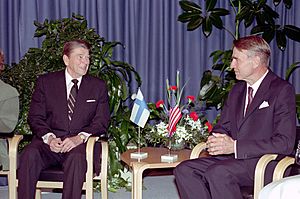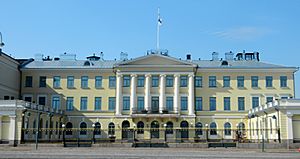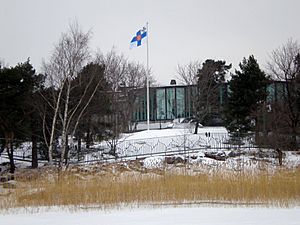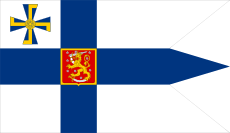President of Finland facts for kids
Quick facts for kids President of the Republic of Finland |
|
|---|---|

Presidential Standard
|
|
| Executive branch of the Finnish Government Office of the President of Finland |
|
| Style |
|
| Residence |
|
| Appointer | Direct election |
| Term length | Six years,
renewable once consecutively
|
| Constituting instrument | Constitution of Finland (2000) |
| Inaugural holder | Kaarlo Juho Ståhlberg |
| Formation | 26 July 1919 |
| Deputy | Prime Minister of Finland |
| Salary | €160,000 annually |
| Website | President of the Republic of Finland |
The President of the Republic of Finland is the head of state of Finland. This means they are the top leader of the country. The current president is Alexander Stubb. He started his job on March 1, 2024. He was chosen by the people of Finland in the 2024 election.
The president is chosen directly by the people. They serve for six years. A president can only be elected twice in a row. To become president, you must be a Finnish citizen from birth. The job of president was created in 1919. The president shares power with the Finnish Government. The president is the highest-ranking person in Finland's official order.
For a long time, Finland had a system where the president had a lot of power. This included power over foreign and domestic issues. But over the years, the president's powers have been reduced. Finland is now more like a parliamentary system. Still, the president helps lead Finland's foreign policy. They are also the commander-in-chief of the Finnish Defence Forces. This means they are in charge of the military.
Contents
- What is the President's Official Title?
- How is the President Elected?
- What Happens at the Inauguration?
- What are Presidential Sessions?
- What are the President's Duties and Powers?
- Can the President Call Early Elections?
- How Does the President Appoint Ministers?
- What Other People Does the President Appoint?
- How Does the President Handle International Relations?
- What is the President's Role in Making Laws?
- Can the President Grant Pardons?
- Commander-in-Chief of the Defence Forces
- Emergency Powers
- What About Decorations and Honors?
- Important Speeches
- What is the President's Salary?
- Official Residences
- What Happens if the President Cannot Do Their Job?
- Can the President Be Removed from Office?
- History of the Presidency
- Timeline of Presidents
- See also
What is the President's Official Title?
Officially, the leader of Finland is called the President of the Republic of Finland. People often just say "President of the Republic." Once a president's term ends, they still keep the title "President."
How is the President Elected?
People who want to be president can be nominated by political parties. These parties must have at least one seat in the last parliamentary election. Also, 20,000 citizens can nominate a candidate.
Since 1994, the president has been chosen by a direct vote from the people. If only one person is nominated, they become president without an election. If there are many candidates, the first round of voting happens in January. If one candidate gets more than half of the votes, they win. If no one gets a majority, the top two candidates have a second round of voting. This happens two weeks later. The person with the most votes in the second round wins. If there's a tie, they draw lots to decide.
The new president starts their job on the first day of the month after the election. This is either February 1 or March 1.
Special Elections in History
There have been a few times when presidents were chosen in special ways. For example, the first president, Kaarlo Juho Ståhlberg, was chosen by the parliament. This was because of a special rule when the constitution was new. During wars, the president was sometimes chosen by a special group or by parliament. This happened in 1940, 1943, 1944, and 1946. In 1973, President Urho Kekkonen's term was extended by a special law.
What Happens at the Inauguration?
The person who won the election becomes president at a special ceremony. This happens at the Parliament House. The new president makes a promise in both Finnish and Swedish. They promise to follow the Constitution and laws. They also promise to work for the good of the people of Finland.
The new president's term begins right after they make this promise. After the ceremony, the new president and the old president inspect a guard of honor outside Parliament House.
What are Presidential Sessions?

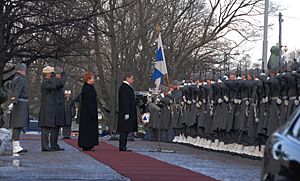
The president works with the Finnish Government in special meetings. These meetings usually happen once a week. During these sessions, ministers present ideas and proposals. The president then makes decisions based on these proposals. The president can also ask the government to think about a proposal again.
What are the President's Duties and Powers?
The president's jobs and powers are written in the Constitution. The president shares executive power with the Government. This means they work together to lead the country. It is a tradition that the president does not belong to a political party while in office. This helps them stay fair and above daily politics.
The president used to have more power, especially in foreign policy. Changes made in 1999 reduced some of these powers. But presidents are still seen as important for stability. This is because it's hard for one party to win a clear majority in Parliament.
Can the President Call Early Elections?
The president can order early parliamentary elections. This happens if the prime minister suggests it. The president must also talk with the political groups in Parliament first. The new parliament then serves a normal four-year term. Presidents have called early elections seven times in history. The president also officially opens and closes each year's session of parliament with a speech.
How Does the President Appoint Ministers?
The president appoints the prime minister and other government members. After an election, the president talks with political groups. Then, they suggest a person to be prime minister to Parliament. If Parliament agrees, the president officially appoints the prime minister and other ministers. If the government loses Parliament's trust, the president must dismiss them.
What Other People Does the President Appoint?
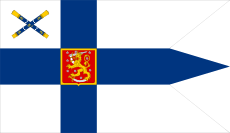
The president appoints many important officials. These include:
- Leaders of the Bank of Finland.
- The Chancellor of Justice, who makes sure laws are followed.
- The Prosecutor-General, who leads public prosecutions.
- Ambassadors to other countries.
- Leaders of Kela, Finland's social insurance institution.
- Officers in the Finnish Defence Forces and Finnish Border Guard.
- Judges, including those in the Supreme Court.
How Does the President Handle International Relations?
The president leads Finland's foreign policy. They work together with the Finnish Government. Important international agreements that affect Finnish laws are approved by Parliament. Other agreements are handled by the president. Decisions about war and peace are made by the president with Parliament's approval.
What is the President's Role in Making Laws?
The president must sign and approve all laws passed by Parliament. They have three months to do this. The president can ask the Supreme Court for advice before signing. If the president doesn't sign a bill, Parliament can vote on it again. If Parliament passes it again, it becomes law without the president's signature.
Can the President Grant Pardons?
The president has the power to pardon someone from a punishment given by a court. This is for individual cases. A general pardon for many people needs a law from Parliament.
The power to pardon has been used to shorten life sentences. In 2006, the power to parole people with life sentences moved to the Helsinki Court of Appeals. But the president still has the power to grant pardons in other cases.
Commander-in-Chief of the Defence Forces
The president is the commander-in-chief of the Finnish Defence Forces. This means they are the top leader of the military. The president can give this role to another Finnish citizen, but this is rare. It last happened during the Second World War. The president appoints military officers and decides when to mobilize the military. If Parliament is not meeting when the military is mobilized, it must be called together right away.
The president makes decisions about military orders with the prime minister and the minister of defense.
Emergency Powers
In special situations, like a big crisis, the president can issue a decree. This allows the government to use emergency powers for up to one year. Parliament must approve this decree. If these powers are not enough, the president can declare a state of defense. This can last for up to three months at first and can be extended. Parliament must also approve this.
What About Decorations and Honors?

The president gives out special awards and medals. These include the Order of the White Rose of Finland and the Order of the Lion of Finland. They are given to Finnish and foreign citizens. The president also awards honorary titles, like "professor" or "counsellor." These titles are symbolic and do not come with responsibilities. The highest titles are valtioneuvos (statesman) and vuorineuvos (industrial).
Important Speeches
The president gives several important speeches each year. The most famous are the New Year's Speech on January 1. They also give a speech at the opening of each annual session of parliament.
What is the President's Salary?
Since March 1, 2024, the president receives an annual salary of 160,000 euros. This salary and other benefits are not taxed. Presidents who serve for six years or more also get a pension. They also get an apartment and staff.
Official Residences
The president has three official properties. These are used for living and for official events. They are the Presidential Palace and Mäntyniemi in Helsinki. The third is Kultaranta in Naantali, which is a summer home.
What Happens if the President Cannot Do Their Job?
Finland does not have a vice president. If the president cannot do their job for a short time, the prime minister acts as president. If the prime minister also cannot, then the deputy prime minister takes over. If the president dies or is permanently unable to do their job, a new election is held.
Can the President Be Removed from Office?
If the president is thought to have committed serious crimes, like treason, Parliament can decide to bring charges. If three-fourths of Parliament votes for it, the president is tried in a special court. The president steps down from office during this time.
History of the Presidency
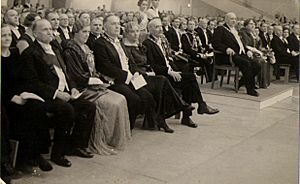
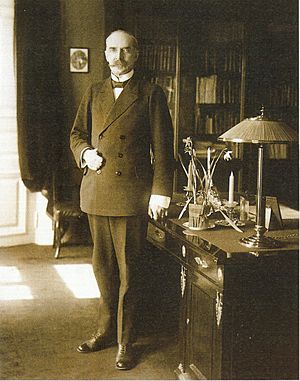
After Finland became independent in 1917, there was a debate about whether Finland should be a republic or a monarchy. They decided on a compromise: a strong president with many powers. These powers included foreign affairs and appointing government officials. In 2000, the Constitution was changed. Some of the president's power was given to Parliament and the Government. For example, the president can no longer choose the prime minister or ministers on their own.
Leaders Before the Republic
Before Finland became a republic with a president, it had other leaders. From 1917 to 1919, Finland had "Regents." These were temporary leaders.
- Pehr Evind Svinhufvud, Regent (1918)
- Carl Gustaf Emil Mannerheim, Regent (1918–1919)
Both Svinhufvud and Mannerheim later became presidents of Finland.
- Gallery of Presidential state cars from different eras
-
Cadillac from 1956
-
Mercedes-Benz from the 1990s
Timeline of Presidents

See also
 In Spanish: Presidente de Finlandia para niños
In Spanish: Presidente de Finlandia para niños
- Prime Minister of Finland
- List of presidents of Finland
- Political parties in Finland



